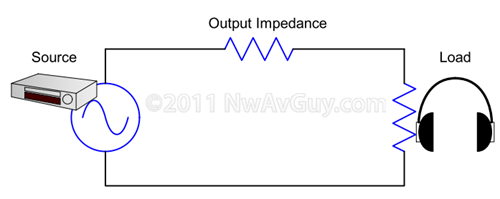manbear
Headphoneus Supremus
- Joined
- Aug 4, 2011
- Posts
- 1,896
- Likes
- 234
I'd like to check with the folks of Sound Science to make sure I'm understanding these concepts correctly. Let's imagine we have two of the same planar magnetic headphones (how about an HE-400 with a flat impedance of 35 ohms), hooked up to two different amps. Amp #1 is a SS speaker amp with 300 ohm series resistors on the outputs. It has an output impedance of ~300 ohms and a max power of ~120 mw into a 35 ohm load. Amp #2 is a SS headphone amp with <1 ohm output impedance and a max power of 1.2 W into the same load.
These numbers are just for example though -- the whole point is that I don't think they make any difference if neither amp is clipping. I am aware that some measurements have put the impedance of the HE-400 at 50 ohms, not 35, but that shouldn't affect any of the following.
Suppose we play white noise through the amps and adjust the volume knobs until volume is equal through both headphones and neither amp is clipping (say 80db). Let's take some measurements across the drivers of the headphones.
By my logic:
1) Since volume is equal, the voltage through both headphones must be equal.
2) Since both headphones have the same impedance at all frequencies, and that impedance is constant across all frequencies (being planar headphones), Ohm's law tells us that the current through the headphones is the same.
3) Take the same voltage, the same current, and the same impedance, and use Ohm's law again to conclude that power through both headphones is the same.
4) Since the impedance of the headphones is constant with respect to frequency, damping factor does not affect the sound and amp #1 is not "boomier" or whatever than amp #2.
Corollary:
If an iPod doesn't clip at a given volume, then it is putting the exact same power, voltage, and current through the HE-400 as, say, a Cavalli Liquid Gold or Headamp GS-X at the same volume.
Questions:
Have I made a mistake anywhere?
Can the output impedance of some amplifiers (e.g. tube amps) vary with respect to frequency and how would this affect 4)? Is there any reason to the think that an SS speaker amp with non-inductive resistors on the outputs would have a changing output impedance?
These numbers are just for example though -- the whole point is that I don't think they make any difference if neither amp is clipping. I am aware that some measurements have put the impedance of the HE-400 at 50 ohms, not 35, but that shouldn't affect any of the following.
Suppose we play white noise through the amps and adjust the volume knobs until volume is equal through both headphones and neither amp is clipping (say 80db). Let's take some measurements across the drivers of the headphones.
By my logic:
1) Since volume is equal, the voltage through both headphones must be equal.
2) Since both headphones have the same impedance at all frequencies, and that impedance is constant across all frequencies (being planar headphones), Ohm's law tells us that the current through the headphones is the same.
3) Take the same voltage, the same current, and the same impedance, and use Ohm's law again to conclude that power through both headphones is the same.
4) Since the impedance of the headphones is constant with respect to frequency, damping factor does not affect the sound and amp #1 is not "boomier" or whatever than amp #2.
Corollary:
If an iPod doesn't clip at a given volume, then it is putting the exact same power, voltage, and current through the HE-400 as, say, a Cavalli Liquid Gold or Headamp GS-X at the same volume.
Questions:
Have I made a mistake anywhere?
Can the output impedance of some amplifiers (e.g. tube amps) vary with respect to frequency and how would this affect 4)? Is there any reason to the think that an SS speaker amp with non-inductive resistors on the outputs would have a changing output impedance?






